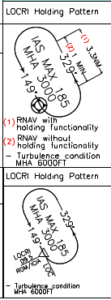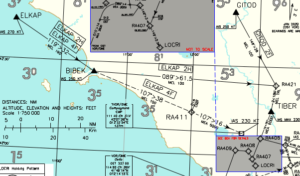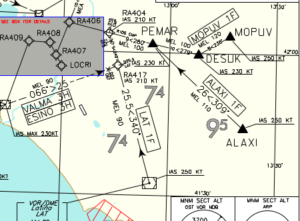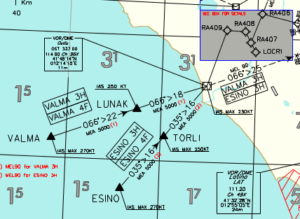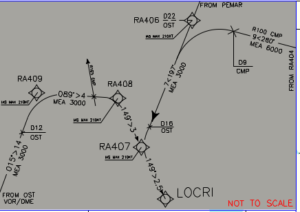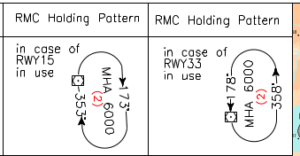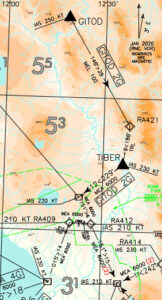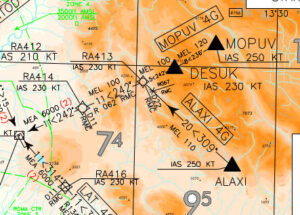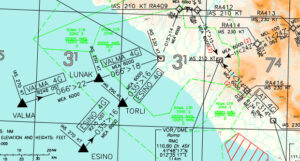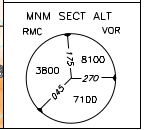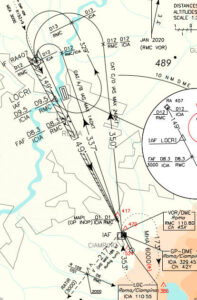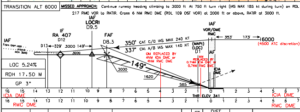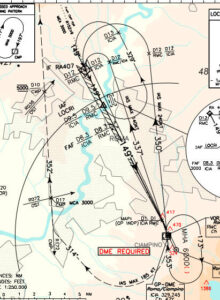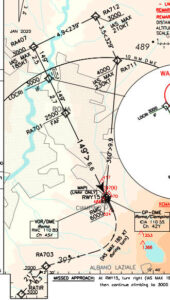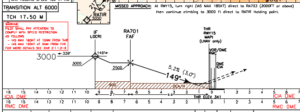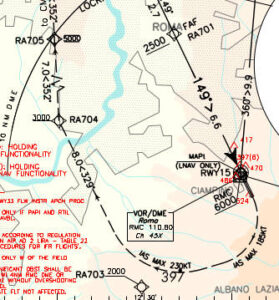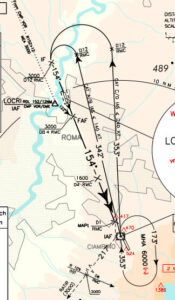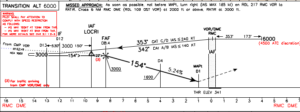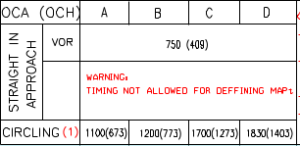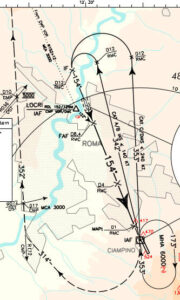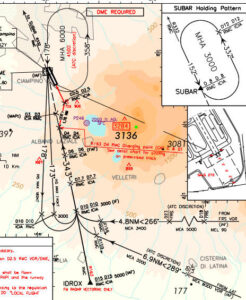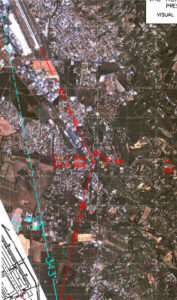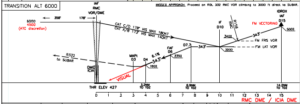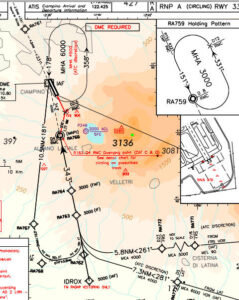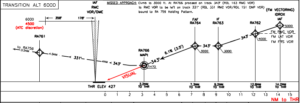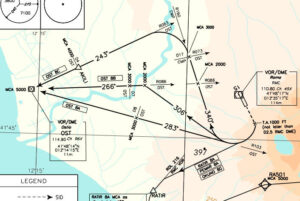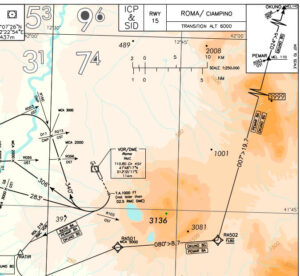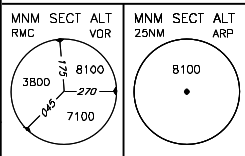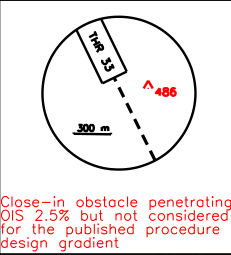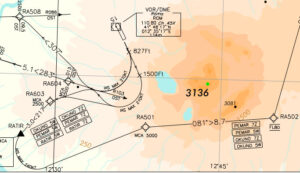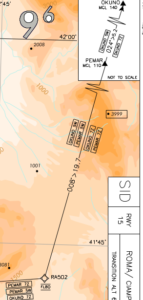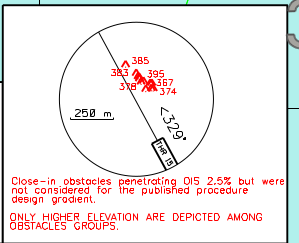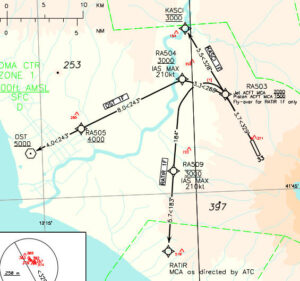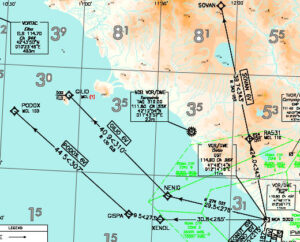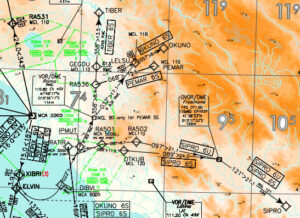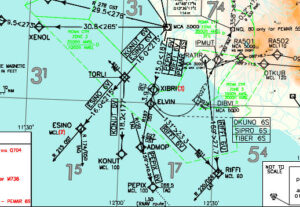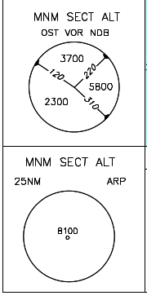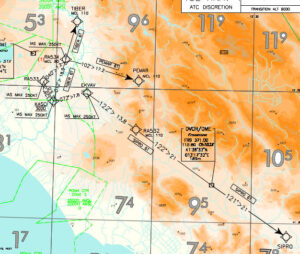Le più recenti modifiche apportate alle procedure strumentali di Roma Ciampino sono:
– variazione dell’identificativo apparato VOR/DME ‘ROM’ (110.80 Mhz/CH45X) per leggere: ‘RMC’
(AIRAC A7/22, in vigore dal 11 Agosto 2022)
– revisione completa delle SID a causa di un aggiornamento della variazione magnetica
(AIRAC A2/24, in vigore dal 22 Febbraio 2024)
The most recent change made to Ciampino instrument procedures is as follows:
– Change of VOR/DME apparatus identifier ‘ROM’ (110.80 Mhz/CH45X) to read: ‘RMC’
(AIRAC A7/22, effective August 11, 2022)
– complete review due to an update of magnetic variation value
(AIRAC A2/24, effective February 22, 2024)
/////
STAR
STAR Conventional and RNAV1
In questa carta le STAR conducono agli IAF LOCRI e CMP VOR/DME, sui quali sono attestati dei circuiti d’attesa (su LOCRI anche RNAV1).
In this chart, the STAR lead to IAF LOCRI and CMP VOR/DME, on which holding patterns are established (on LOCRI also RNAV1).
Ma circuiti d’attesa sono attestati anche sui waypoints BIBEK, ESINO, LAT VOR/DME, TIBER e VALMA.
holding patterns are also established on the waypoints BIBEK, ESINO, LAT VOR/DME, TIBER and VALMA.
STAR da Nord / STAR from North:
GITOD 2F
GITOD – TR 146° – RA421 (+FL100) – TR 186° – TIBER (+TRL) – TR 197° – RA406 (+6000ft) – RA407 (+3000ft) – TR 149° – LOCRI
ELKAP 2H (RNAV1)
ELKAP – TR 119° – BIBEK (+FL190) – TR 089° – RA421 (+FL100) – TR 186° – TIBER (+TRL) – TR 197° – RA406 (+6000ft) – RA407 (+3000ft) – TR 149° – LOCRI
ELKAP 4F (At ATC discretion)
ELKAP – TR 119° – BIBEK (+FL190) – TR 107° – RA411 (+FL100) – CMP (+5000ft)
STAR da Est / STAR from East:
MOPUV 1F
MOPUV (+FL120) – TR 236° – DESUK – TR 279° – PEMAR (+FL100) – TR 280° – RA404 – RA406 (+6000ft) – TR 197° – RA407 (+3000ft) – TR 149° – LOCRI
ALAXI 1F
ALAXI (+FL110) – TR 309° – PEMAR – TR 280° – RA404 (+FL100) – RA406 (+6000ft) – TR 197° – RA407 (+3000ft) – TR 149° – LOCRI
STAR da Sud / STAR from South:
LAT 1F
LAT (+FL90) – TR 340° – RA404 (+FL90) – TR 280° – RA406 (+6000ft) – TR 197° – RA407 (+3000ft) – TR 149° – LOCRI
ESINO 4F
ESINO (+5000ft) – TR 035° – TORLI – OST – TR 015° – RA409 (+3000ft) – TR 089° – RA408 – TR 149° – RA407 – LOCRI
ESINO 3H (at ATC discretion)
ESINO (+FL90) – TR 035° – TORLI – OST – TR 066° – RA417 – TR 340° – RA404 – TR 280° – RA406 (+6000ft) – TR 197° – RA407 (+3000ft) – TR 149° – LOCRI
VALMA 4F
VALMA (+5000ft) – TR 066° – LUNAK – OST – TR 015° – RA409 (+3000ft) – TR 089° – RA408 – TR 149° – RA407 – LOCRI
VALMA 3H (At ATC discretion)
VALMA (+FL90) – TR 066° – LUNAK – OST – RA417 – TR 340° – RA404 – TR 280° – RA406 (+6000ft) – TR 197° – RA407 (+3000ft) – TR 149° – LOCRI
Nella prossima immagine, un dettaglio dell’ultimo tratto delle STAR, a partire dai waypoints RA409 e RA406:
In the next image, a detail of the last segment of the STAR, starting at waypoints RA409 and RA406:
La MSA basata sull’ARP, consta di un unico settore, a 8100ft.
Segue la rappresentazione grafica della MSA basata su OST VOR:
The MSA based on ARP, consists of a single sector, at 8100ft.
A graphical representation of the OST VOR-based MSA follows:
_____
STAR Conventional and RNAV1 (at ATC discretion)
In questa carta le STAR conducono allo IAF RMC VOR/DME, sul quale è attestato un circuito d’attesa.
In this chart, the STAR lead to the IAF RMC VOR/DME, on which a holding pattern is established.
Ma circuiti d’attesa sono attestati anche sui waypoints CMP VOR/DME, ESINO, LAT VOR/DME, TIBER e VALMA:
Holding patterns are also established on the CMP VOR/DME, ESINO, LAT VOR/DME, TIBER and VALMA waypoints:
STAR da Nord / STAR from North:
GITOD 2G
GITOD – TR 146° – RA421 (+FL100) – TR 186° – TIBER (+TRL) – TR 229° – CMP (+6000ft) – TR 151° – RA412 – RMC (+6000ft or +4500ft at ATC discretion)
STAR da Est / STAR from East:
MOPUV 4G
MOPUV – TR 236° – DESUK (+FL120) – TR 242° – RA413 (+FL100) – RA414 – RMC (+6000ft o +4500ft a discrezione ATC)
Nota: per performance di navigazione convenzionali MEA 6000ft partirà dal punto RDL 062/11NM RMC VOR/DME
Remark: For conventional navigation performance, MEA 6000ft shall start at RDL 062/D11 RMC VOR/DME
ALAXI 4G
ALAXI – TR 309° – RA413 (+FL110) – TR 242° – RA414 (+FL100) – RMC (+6000ft o +4500ft a discrezione ATC)
Nota:
per performance di navigazione convenzionali si applica quanto segue:
– MEA 6000ft deve partire dal punto RDL 062/11NM RMC VOR/DME
– la virata verso RA414 deve partire dal punto INT TR 309°/RDL 067 RMC VOR
– MEL 100 deve partire dal punto RDL 062/22NM RMC VOR/DME
Remark:
For conventional navigation performance following provisions apply:
– MEA 6000ft shall start at RDL 062/11NM RMC VOR/DME
– turn to RA414 shall start at INT TR309°/RDL 067 RMC VOR
– MEL100 shall start at RDL 062/22NM RMC VOR/DME
STAR da Sud / STAR from South:
LAT 4G
LAT – TR 314° – RA416 (+FL90) – RMC (+6000ft o +4500ft a discrezione ATC)
Nota / Remark:
per performance di navigazione convenzionali MEA 6000ft partirà dal punto RDL 134/11NM RMC VOR/DME
For conventional navigation performance, MEA 6000ft shall start at RDL 134/D11 RMC VOR/DME
ESINO 4G
ESINO – TR 035° – TORLI (+6000ft) – OST – TR 015° – RA409 – TR 089° – RA412 – TR 151° – RMC (+6000ft o +4500ft a discrezione ATC)
Nota:
per performance di navigazione convenzionali si applica quanto segue:
– la virata verso RA412 deve partire dal punto RDL 015/12NM OST VOR/DME
– la virata verso RMC VOR/DME deve partire dal punto INT TR 089°/RDL 165 CMP VOR
Remark:
For conventional navigation performance following provisions apply:
– turn to RA412 shall start at RDL 015/12NM OST VOR/DME
– turn to RMC VOR/DME shall start at INT TR 089°/RDL 165 CMP VOR
VALMA 4G
VALMA – TR 066° – LUNAK (+6000ft) – OST – TR 015° – RA409 – TR 089° – RA412 – TR 151° – RMC (+6000ft o +4500ft a discrezione ATC)
Nota:
per performance di navigazione convenzionali si applica quanto segue:
– la virata verso RA412 deve partire dal punto RDL 015/12NM OST VOR/DME
– la virata verso RMC VOR/DME deve partire dal punto INT TR 089°/RDL 164 CMP VOR
Remark:
For conventional navigation performance following provisions apply:
– turn to RA412 shall start at RDL 015/12NM OST VOR/DME
– turn to RMC VOR/DME shall start at INT TR 089°/RDL 164 CMP VOR
La MSA basata sull’ARP, consta di un unico settore, a 8100ft.
Segue la rappresentazione grafica della MSA basata su RMC VOR:
The MSA based on ARP, consists of a single sector, at 8100ft.
A graphical representation of the RMC VOR-based MSA follows:
_____
_____
Procedure strumentali di avvicinamento
ILS or LOC-Z RWY 15
IAF su CMP VOR/DME, LOCRI e RMC VOR/DME, dove sono attestati anche dei circuiti di attesa.
IAF on CMP VOR/DME, LOCRI, and RMC VOR/DME, where holding patterns are also established.
Segmento iniziale da CMP (+3000ft):
RDL 152 CMP fino all’IF RA407.
da LOCRI (+3000ft):
Racetrack (outbound 329°) per presentarsi all’IF RA407.
Segmento iniziale da RMC (+6000ft o +4500ft a discrezione ATC):
Tratto outbound su TR 350° (CAT C/D IAS MAX 240kt) o su TR 337° (CAT A/B IAS MAX 140kt). A 12 NM RMC o ICIA DME, virata a sinistra per presentarsi all’IF RA407.
Initial segment from CMP (+3000ft):
RDL 152 CMP to IF RA407.
from LOCRI (+3000ft):
Racetrack (outbound 329°) until IF (RA407).
Initial segment from RMC (+6000ft or +4500ft at ATC discretion):
Outbound segment on TR 350° (CAT C/D IAS MAX 240kt) or on TR 337° (CAT A/B IAS MAX 140kt). At 12 NM RMC or ICIA DME, left turn until IF (RA407).
////
FAF a D8.3 ICIA / RMC, segmento finale su TR 149°.
MAPt (GP INOP) posto a 1NM RMC/ICIA DME.
La posizione OM è sostituita dalla distanza 4NM da ICIA/RMC DME (1620ft).
La posizione MM è sostituita dalla distanza 0.7NM ICIA/RMC DME (565ft)
La procedura di mancato avvicinamento conduce ad un’attesa sul punto RATIR.
FAF at D8.3 ICIA / RMC, final segment on TR 149°.
MAPt (GP INOP) located at 1NM RMC/ICIA DME.
OM position is replaced by 4NM distance from ICIA/RMC DME (1620ft).
MM position is replaced by 0.7NM ICIA/RMC DME distance (565ft)
The missed approach procedure leads to a holding pattern on RATIR.
Ecco la procedura vista in profilo:
Profile view:
e le minime
minima
____
ILS or LOC-Y RWY 15
Differisce dalla ILS or LOC-Z RWY 15 per la sola procedura di mancato avvicinamento, che prevede un circuito d’attesa sul VOR/DME di Campagnano CMP, anzichè su RATIR.
It differs from ILS or LOC-Z RWY 15 only in the missed approach procedure, which involves an holding pattern on Campagnano CMP VOR/DME, instead of on waypoint RATIR.
_____
RNP-Z RWY 15
IAF sul waypoint RMC, sul quale è previsto anche un circuito d’attesa RNAV1 (inbound 353°/outbound 173°, +6000ft o +4500ft ATC discretion)
IAF on RMC waypoint, on which is also established an RNAV1 holding pattern (inbound 353°/outbound 173°, +6000ft or +4500ft ATC discretion)
Segmento iniziale / initial segment:
RMC (+6000ft) – TR 360° – RA711 (+4000ft, IAS MAX 230kt) – TR 329° – RA712 (+3000ft, IAS MAX 210kt) – TR 239° – RA407 (IAS MAX 185kt) – TR 149° – LOCRI (IF, IAS MAX 185kt)
Quindi / Then:
TR 149° – RA701 (FAF, +2500ft, IAS MAX 185kt ) and final segment on TR 149°
MAPt LNAV only su THR 15 (flyover WPT, IAS MAX 185kt) e procedura di mancato avvicinamento che prevede un circuito d’attesa RNAV1 su RATIR (inbound 315°/outbound 135°, +3000ft,IAS MAX 185kt, MAX holding ALT: 6000ft)
virata a destra su RA703 (+2000ft, IAS MAX 185kt) – TR 217° – RATIR (+3000ft)
MAPt LNAV only on THR 15 (flyover WPT, IAS MAX 185kt) and missed approach procedure involving a RNAV1 holding pattern on RATIR (inbound 315°/outbound 135°, +3000ft,IAS MAX 185kt, MAX holding ALT: 6000ft)
right turn on RA703 (+2000ft, IAS MAX 185kt) – TR 217° – RATIR (+3000ft)
/////
Rappresentazione dei circuiti d’attesa RNAV1 sui waypoints RMC, LOCRI e RATIR:
Representation of RNAV1 holding patterns on WPT RMC, LOCRI e RATIR:
vista in profilo / profile view:
Al di fuori dei circuiti di attesa, la procedura è basata su specifiche di navigazione RNP APCH.
Except for the holding patterns, the procedure is based on RNP APCH navigation specifications.
Minime / minima:
Osservazioni:
1) una nota sulla carta segnala la presenza di ostacoli che penetrano la Visual Segment Surface (VSS).
2) la procedura viene dichiarata “DME required”, anche se non riesco ad individuare le relative indicazioni di distanza dai DME.
Remarks:
1) a note on the chart indicates the presence of obstacles penetrating the Visual Segment Surface (VSS).
2) the procedure is stated as “DME required”, although I can’t locate the relevant distance indications from the DMEs.
____
RNP-Y RWY 15
Differisce dalla RNP-Z RWY 15 per la sola procedura di mancato avvicinamento, che prevede un circuito d’attesa su CMP, anziché su RATIR:
virata a destra su RA703 (+2000ft) – TR 329° – RA704 (+3000ft) – TR 352° – RA705 (5000ft steady) – CMP (+5000ft)
It differs from RNP-Z RWY 15 only in the missed approach procedure, which involves a holding pattern on CMP, instead of on RATIR:
right turn on RA703 (+2000ft) – TR 329° – RA704 (+3000ft) – TR 352° – RA705 (5000ft steady) – CMP (+5000ft)
Al di fuori dei circuiti di attesa, la procedura è basata su specifiche di navigazione RNP APCH.
Osservazioni:
1) una nota sulla carta segnala la presenza di ostacoli che penetrano la Visual Segment Surface (VSS).
2) la procedura viene dichiarata “DME required”, anche se non riesco ad individuare le relative indicazioni di distanza dai DME.
Remarks:
1) a note on the chart indicates the presence of obstacles penetrating the Visual Segment Surface (VSS).
2) the procedure is stated as “DME required”, although I can’t locate the relevant distance indications from the DMEs.
____
VOR-Z RWY 15
IAF su LOCRI e RMC VOR/DME, con segmento che da CMP VOR/DME conduce a LOCRI.
Il circuito d’attesa su LOCRI differisce nell’orientamento da quello già visto per la ILS or LOC-Z RWY 15
IAF on LOCRI and RMC VOR/DME, with segment from CMP VOR/DME leading to LOCRI.
The holding pattern on LOCRI differs in orientation from that already seen for the ILS or LOC-Z RWY 15
da LOCRI (+3000ft):
TR 122° fino al FAF (RDL 334/D8.4 RMC, +3000ft)
da RMC (+6000ft o +4500ft a discrezione ATC):
Tratto outbound su TR 353° (CAT C/D IAS MAX 240kt) o su TR 342° (CAT A/B IAS MAX 140kt). A 12 NM RMC, virata a sinistra per presentarsi all’IF (RDL 334/D12 RMC, +3000ft).
from LOCRI (+3000ft):
TR 122° until FAF (RDL 334/D8.4 RMC, +3000ft)
from RMC (+6000ft or +4500ft at ATC discretion):
Outbound leg on TR 353° (CAT C/D IAS MAX 240kt) or on TR 342° (CAT A/B IAS MAX 140kt). At 12 NM RMC, left turn to IF (RDL 334/D12 RMC, +3000ft).
FAF a D8.4 RMC, segmento finale su TR 154°.
MAPt posto a 1NM RMC DME.
La procedura di mancato avvicinamento conduce ad un’attesa sul punto RATIR
FAF at D8.4 RMC, final segment on TR 154°
MAPt placed at 1NM RMC DME.
The missed approach procedure leads to an holding pattern on RATIR
Ecco la procedura vista in profilo:
Profile view:
e le minime
minima
_______
VOR-Y RWY 15
Differisce dalla VOR-Z RWY 15 per la sola procedura di mancato avvicinamento, che prevede un circuito d’attesa su CMP, anziché su RATIR:
virata a destra su TR 314° per intercettare RDL 172 CMP VOR (a 17NM CMP DME: +3000ft; a 10NM CMP DME: 5000ft steady) – TR 352° fino a CMP VOR/DME (+5000ft)
It differs from VOR-Z RWY 15 only in the missed approach procedure, which involves an holding pattern on CMP instead of on RATIR:
right turn on TR 314° to intercept RDL 172 CMP VOR (at 17NM CMP DME: +3000ft; at 10NM CMP DME: 5000ft steady) – TR 352° to CMP VOR/DME (+5000ft)
_____
CIRCLING RWY 33 a seguito di procedure strumentali per RWY 15
– è consentito solo se il PAPI e le luci di identificazione soglia RWY 33 sono funzionanti;
– è consentito applicando quanto pubblicato in AIP AD 2 LIRA – paragrafo 20 “Restrizioni per i voli locali”
– è consentito solo a Ovest del campo
– a causa della presenza di ostacoli significativi, la procedura deve essere effettuata entro le 4NM da RMC DME senza sorvolare l’estensione dell’asse centrale della pista. Questa limitazione non riguarda i voli di Stato e militari.
CIRCLING RWY 33 following an instrument procedure for RWY 15
– it is only allowed if PAPI and RWY 33 threshold identification lights are operational;
– it is permitted applying what is published in AIP AD 2 LIRA – item 20 ‘Restrictions for local flights’.
– it is only permitted West of the field
– due to the presence of significant obstacles, the procedure must be performed within 4NM from RMC DME without flying over the extension of the runway centerline. This restriction does not apply to State and military flights.
_____
VOR-A circling RWY 33 (at ATC discretion)
IAF su LAT VOR/DME, IDROX, FRS VOR/DME e RMC VOR/DME.
Segmento iniziale da LAT (a discrezione ATC, +6000ft):
TR 289° (a 5NM LAT DME: +3000ft) – INT RDL 159 RMC VOR – virata a destra per intercettare RDL 163 RMC VOR e l’IF (10NM RMC/ICIA DME)
Segmento iniziale da FRS (a discrezione ATC, +FL90):
TR 266° (a 18NM FRS DME: +5000ft; a 23NM FRS DME: +3400ft) – INT RDL 156 RMC VOR – virata a destra per intercettare RDL 163 RMC VOR e l’IF (10NM RMC/ICIA DME)
Segmento iniziale da IDROX (da vettoramento radar, +5000ft):
TR 343° (RDL 163 RMC VOR) fino all’IF (10NM RMC/ICIA DME, +3000ft)
Segmento iniziale da RMC (+6000ft, o +4500ft a discrezione ATC):
tratto outbound su TR 178° (IAS MAX 180kt) o TR 173° (IAS MAX 140kt). A 10NM RMC/ICIA DME virata a sinistra per intercettare RDL 163 RMC fino all’IF (10NM RMC/ICIA DME, +3000ft)
FAF a 6NM RMC/ICIA DME su RDL 163 RMC VOR (TR 343°) (non allineati con l’asse longitudinale della RWY 33).
MAPt a 3NM RMC/ICIA DME e mancato avvicinamento che prevede il proseguimento su RDL 332 RMC VOR fino a SUBAR ed al suo circuito d’attesa.
English text:
IAF on LAT VOR/DME, IDROX, FRS VOR/DME and RMC VOR/DME.
Initial segment from LAT (at ATC discretion, +6000ft):
TR 289° (at 5NM LAT DME: +3000ft) – INT RDL 159 RMC VOR – turn right to intercept RDL 163 RMC VOR and the IF (10NM RMC/ICIA DME)
Initial segment from FRS (at ATC discretion, +FL90):
TR 266° (at 18NM FRS DME: +5000ft; at 23NM FRS DME: +3400ft) – INT RDL 156 RMC VOR – right turn to intercept RDL 163 RMC VOR and the IF (10NM RMC/ICIA DME)
Initial segment from IDROX (from radar vectoring, +5000ft):
TR 343° (RDL 163 RMC VOR) to the IF (10NM RMC/ICIA DME, +3000ft)
Initial segment from RMC (+6000ft, or +4500ft at ATC discretion):
Outbound segment on TR 178° (IAS MAX 180kt) or TR 173° (IAS MAX 140kt). At 10NM RMC/ICIA DME left turn to intercept RDL 163 RMC up to IF (10NM RMC/ICIA DME, +3000ft)
FAF at 6NM RMC/ICIA DME on RDL 163 RMC VOR (TR 343°) (not aligned with longitudinal axis of RWY 33).
MAPt at 3NM RMC/ICIA DME and missed approach proceeding on RDL 332 RMC VOR to SUBAR and its holding pattern.
Punto di divergenza (CAT C/D) a 4NM RMC/ICIA DME e inizio del tratto visual:
TR 008° fino a 2.5NM RMC/ICIA DME (posizione: 41°46’06.75”N 012°36’57.84”E), quindi rotta 329° fino all’atterraggio.
Divergence point (CAT C/D) at 4NM RMC/ICIA DME and start of visual segment:
TR 008° to 2.5NM RMC/ICIA DME (location: 41°46’06.75 “N 012°36’57.84 “E), then course 329° to landing.
Vista in profilo / profile view:
Minime:
Circling su “prescribed track” per tutte le categorie – OCA (OCH): 1350ft (923ft)
Note:
– le indicazioni del PAPI e del SALS 270m RWY 33 sono obbligatorie;
– l’efficienza della segnaletica luminosa dell’ ostacolo con elevazione 728ft situato a 2.5NM RMC VOR/DME è mandatoria;
– il segmento “visual” dopo il punto di divergenza deve essere effettuato con contatto visivo del terreno, degli ostacoli, del PAPI e della pista.
– l’effettuazione della procedura è consentita solo applicando quanto pubblicato in AIP AD 2 LIRA – paragrafo 20 “Restrizioni per i voli locali”
/////
Minima:
Circling on “prescribed track” for all categories – OCA (OCH): 1350ft (923ft)
Remarks:
– PAPI and SALS 270m RWY 33 indications are mandatory;
– Availabilty of obstacle light (elevation 728ft) located at 2.5NM RMC VOR/DME is mandatory;
– the “visual” segment after the divergence point shall be performed with visual contact of the terrain, obstacles, PAPI and runway.
– performance of the procedure is allowed only by applying what is published in AIP AD 2 LIRA – paragraph 20 “Restrictions for local flights”.
______
RNP–A circling RWY 33 (at ATC discretion)
IAF su LAT, IDROX, FRS e RMC.
Segmento iniziale da LAT (a discrezione ATC, +6000ft):
TR 281° – RA773 – RA762 (+4000ft)
Segmento iniziale da FRS (a discrezione ATC, +FL90):
TR 261° – RA771 – RA772 (+5000ft) – RA762 (+4000ft)
Segmento iniziale da IDROX (da vettoramento radar, +5000ft):
TR 343° – RA763 (IF, +3000ft)
Segmento iniziale da RMC (+6000ft, o +4500ft a discrezione ATC):
TR 181° – RA767 – TR 163° – RA768 – TR 074° – RA762 (+4000ft)
Quindi:
TR 343° – IF su RA763 (+3000ft) – FAF su RA764 e MAPt su RA766 (flyover WPT).
Nota: la rotta 343° non è allineata con l’asse longitudinale della RWY 33.
Il mancato avvicinamento che prevede il proseguimento su RDL 163 RMC VOR fino a RMC VOR/DME, da lasciare su TR 331° (RDL 331 RMC VOR), quindi RA761, verso il circuito d’attesa su RA759 (flyover WPT, RNAV1).
English text:
IAF on LAT, IDROX, FRS and RMC.
Initial segment from LAT (at ATC discretion, +6000ft):
TR 281° – RA773 – RA762 (+4000ft).
Initial segment from FRS (ATC discretion, +FL90):
TR 261° – RA771 – RA772 (+5000ft) – RA762 (+4000ft)
Initial segment from IDROX (from radar vectoring, +5000ft):
TR 343° – RA763 (IF, +3000ft)
Initial segment from RMC (+6000ft, or +4500ft at ATC discretion):
TR 181° – RA767 – TR 163° – RA768 – TR 074° – RA762 (+4000ft)
Then:
TR 343° – IF on RA763 (+3000ft) – FAF on RA764 and MAPt on RA766 (WPT flyover).
Note: TR 343° is not aligned with the longitudinal axis of RWY 33.
Missed approach proceeding on RDL 163 RMC VOR to RMC VOR/DME, to be left on TR 331° (RDL 331 RMC VOR), then RA761, to the holding pattern on RA759 (flyover WPT, RNAV1).
Punto di divergenza (CAT C/D) su RA766 e inizio del tratto visual:
TR 008° fino a 2.5NM RMC/ICIA DME (posizione: 41°46’06.75”N 012°36’57.84”E), quindi rotta 329° fino all’atterraggio.
Divergence point (CAT C/D) on RA766 waypoint and start of visual segment:
TR 008° to 2.5NM RMC/ICIA DME (location: 41°46’06.75 “N 012°36’57.84 “E), then course 329° to landing.
Vista in profilo / profile view:
Minime:
Circling su “prescribed track” per tutte le categorie – OCA (OCH): 1470ft (1043ft)
____
Note:
– le indicazioni del PAPI e SALS 270m RWY 33 sono obbligatorie;
– l’efficienza della segnaletica luminosa dell’ ostacolo con elevazione 728ft situato a 2.5NM RMC VOR/DME è mandatoria;
– il segmento “visual” dopo il punto di divergenza deve essere effettuato con contatto visivo del terreno, degli ostacoli, del PAPI e della pista.
– l’effettuazione della procedura è consentita solo applicando quanto pubblicato in AIP AD 2 LIRA – paragrafo 20 “Restrizioni per i voli locali”
///
Minima:
Circling on “prescribed track” for all categories – OCA (OCH): 1470ft (1043ft)
Remarks:
– PAPI and SALS 270m RWY 33 indications are mandatory;
– Availabilty of obstacle light (elevation 728ft) located at 2.5NM ROM VOR/DME is mandatory;
– the “visual” segment after the divergence point shall be performed with visual contact of the terrain, obstacles, PAPI and runway.
– performance of the procedure is allowed only by applying what is published in AIP AD 2 LIRA – paragraph 20 “Restrictions for local flights”.
_____
_____
Norme particolari per gli aeromobili in arrivo all’aeroporto di Roma/Ciampino:
I piloti degli aeromobili in arrivo , se non diversamente istruiti dall’Ente ATC, dovranno ridurre la velocità in accordo agli speed limit points pubblicati sulle carte relative alle STAR.
piloti dovranno comunque ridurre la velocità a:
– 210 kt IAS, iniziando la virata per intercettare il LOC, o l’appropriata radiale VOR o rilevamento NDB (in caso di avvicinamenti con finale VOR o NDB) oppure ad una distanza di 12 NM dalla soglia pista in caso di avvicinamento diretto;
– 180 kt IAS al completamento della virata per l’intercettazione, o ad una distanza di 8 NM dalla soglia pista in caso di avvcinamento diretto;
– 160 kt IAS ad una distanza di 4 NM dalla soglia pista.
Inoltre ROMA ACC potrà richiedere ai piloti:
– di regolare in modo specifico la velocità durante l’avvicinamento intermedio;
– di apportare correzioni di velocità dell’ordine massimo di più o meno 20 kt fino ad una distanza di 4 NM dalla soglia pista.
Special instructions for arriving aircraft to Roma/Ciampino aerodrome
Pilots of arriving aircraft, if not otherwise instructed by ATC Unit, shall reduce speed according to speed limit points published on pertinent STAR Charts.
However pilots shall reduce speed to:
– 210 kt IAS, starting the turn to intercept the LOC or the appropriate VOR radial or the NDB reading (in case of VOR or NDB final approaches) or at a distance of 12 NM from RWY threshold in case of straight in approach;
– 180 kt IAS completing the intercepting turn or at a distance of 10 NM from the RWY THR in case of straight-in approach;
– 160 kt IAS at a distance of 6 NM from RWY THR.
Furthermore ROMA ACC may request pilots:
– to adjust speed in a specific manner during the intermediate approach;
– speed adjustment of not more than plus or minus 20 kt until a minimum distance of 4 NM from the RWY THR.
_____
_____
Procedure strumentali di partenza
ICP e SID RWY 15
(Carta rinominata con AIRAC A2/24, in vigore dal 22 Febbraio 2024. Con la stessa variante è stata effettuata una revisione per un aggiornamento della variazione magnetica, sono stati cancellati i riferimenti a URB NDB e la SID URB 7A)
( Chart renamed with AIRAC A2/24, in force from February 22 2024. With the same amendment a revision was made to update the magnetic variation, references to URB NDB and SID URB 7A were deleted)
/////
Salita iniziale / initial climb:
Dopo il decollo, attraversando 1000 ft, virare a destra e proseguire per la SID assegnata.
After take-off, passing 1000ft, turn right and proceed on assigned SID.
NOTE / REMARKS
1. La virata attraversando 1000 ft dovrà essere eseguita non oltre 2.5 NM RMC DME. / Right turn after take-off shall be executed not later
than 2.5 NM RMC DME.
2. Minimum climb gradient 7% (425 ft/NM) due to obstacles.
3. IAS MAX 210 kt durante la virata. Angolo di banco 25° o 3°/s quale delle due misure richiede il banco inferiore. / IAS MAX during turn 210 kt. Bank angle 25° or rate of turn 3°/s, whichever requires the lesser bank.
/////
OST 8A
TR 283° – RDL 103 OST VOR (a 8NM OST DME: +3000ft) – OST VOR/DME (+5000ft)
OST 8B
TR 306° – RDL 086 OST VOR (+2000ft; a 7NM OST DME: +3000ft) – OST VOR/DME (+5000ft)
OST 8C
TR 340° (RDL 160 CMP VOR) (INT RDL 086 OST VOR: +2000ft; a 17 NM CMP DME: +3000ft) – RDL 063 OST VOR – AKILI (+4000ft) – OST VOR/DME (+5000ft)
RATIR 8A
RDL 216 RMC VOR – RATIR (MCL as authorized by ATC)
//////
SID URB 7A cancellata con la variante AIRAC A2/24 / SID URB 7A cancelled by AIRAC A2/24
PEMAR 8A (conventional)
RDL 216 RMC VOR – RATIR (+3000ft) – RA501 (+5000ft) – RA502 (FL 80 steady) – PEMAR (+FL110)
PEMAR 8A (B-RNAV/P-RNAV)
RATIR (flyover waypoint, +3000ft, IAS MAX 240kt) – TR 216° – RA501 (+5000ft) – TR 080° – RA502 (FL 80 steady) – TR 007° – PEMAR (+FL110)
OKUNO 8G (conventional)
RDL 216 RMC VOR – RATIR (+3000ft) – RA501 (+5000ft) – RA502 (FL 80 steady) – PEMAR (+FL110) – OKUNO (+FL140)
OKUNO 8G (B-RNAV/P-RNAV)
RATIR (flyover waypoint, +3000ft, IAS MAX 240kt) – TR 216° – RA501 (+5000ft) – TR 080° – RA502 (FL 80 steady) – TR 007° – PEMAR (+FL110) – TR 024° – OKUNO (+FL140)
MSA
/////
NOTE / REMARKS
1. Autorizzazioni via SID OST saranno seguite da una seconda SID codificata in conformità alle SID di Roma/Fiumicino. / Clearances via SID OST will be followed by a second coded SID, according to Roma/Fiumicino SID.
2. Autorizzazioni via RATIR saranno seguite da istruzioni dettagliate. / Clearances via RATIR shall be followed by detailed instructions.
3. Tutte le virate saranno eseguite /All turns shall be executed:
– IAS non superiore a 210 kt / IAS not exceeding 210 kt;
– angolo di banco 25° oppure rateo di virata non inferiore a 3°/sec., quale delle due misure comporta un banco inferiore. / bank angle 25° or rate of turn not less 3° per second, whichever requires the lesser bank.
4. I piloti devono adottare un gradiente minimo di salita conforme alle prescrizioni dell’Annesso 6 – ICAO per un sicuro sorvolo degli ostacoli. Tale gradiente deve essere mantenuto in ogni circostanza prevedibile. / Pilots shall adopt a minimum climb gradient in accordance with ICAO – Annex 6 provisions for a safe obstacles overflying. Such climb gradient shall be maintained in any foreseeable circumstance.
5. Close-in obstacles:
(AIRAC A13/24, in force from December 26, 2024)
_____
ATTENZIONE / WARNING
Come disposto dall’ENAC DA di Ciampino, al fine di ridurre l’impatto acustico sulle zone limitrofe all’aeroporto di Roma/Ciampino e per favorire il miglior rispetto della traiettoria nominale attesa dagli aeromobili in decollo dalla RWY 15, sono state pubblicate procedure antirumore ICP/SID RWY 15 (Supplemento S47/25, valido fino al 11 Giugno 2026)
Per tutte le SID RWY 15 viene riportata la codifica RNAV, comprensiva della fase di salita iniziale, a supporto dell’inserimento delle stesse nei sistemi di bordo per un più puntuale rispetto della traiettoria.
As determined by Ciampino aerodrome CAA, in order to reduce the acoustic impact in the neighborhood of Roma/Ciampino airport and to facilitate the nominal flight path for aircraft taking off from RWY 15, with the present supplement noise abatement procedures ICP/SID are published. (Supplement S47/25, in force until June 11, 2026)
All the SIDs RWY 15 are codified RNAV, initial climb included, to be integrated into onboard flight systems for a more precise respect of trajectory.
/////
SID RWY 15
NOTE / REMARKS
1. La seguente procedura operativa di abbattimento del rumore al decollo (NAPD1) deve essere applicata per gli aerei a turbogetto: / Following operational Noise Abatement Take-Off Procedure (NAPD1) must be applied for outbound turbo-jet aircraft:
‐ From TKOF to 1500 ft: Climb speed V2 plus 10 to 20 kt or as limited by body angle, at maximum gradient compatible with safety and not less than 14%;
‐ At 1500 ft: Adjust and maintain engine power/thrust in accordance with the noise abatement power/thrust schedule provided in the ACFT operating manual, maintaining maximum gradient compatible with safety and not less than 14%;
‐ At 3000 ft: Accelerate smoothly to en-route climb speed with flaps retraction;
2. RNAV1 equipment recommended.
3. Clearances via SID RATIR shall be followed by detailed instructions.
_____
OST 7Z (conventional)
passing 827ft – TR 283° (RDL 103 OST VOR) (a 13NM OST DME: +2500ft; a 8 NM OST DME:+3500ft) – RA604 – RA507 – OST VOR/DME (+5000ft)
OST 7Z (RNAV1)
TR 151° (+827ft) – TR 283° – RA604 (+2500ft) – RA507 (+3500ft) – OST (+5000ft)
OST 7Y (conventional)
passing 827ft – TR 307° – INT RDL 086/8.5NM OST VOR/DME (+2500ft) – RDL 086 OST VOR (a 7NM OST DME: +3500ft) – OST VOR/DME (+5000ft)
OST 7Y (RNAV1)
TR 151° (+827ft) – TR 307° – RA508 (+2500ft) – TR 266° – RA506 (+3500ft) – OST (+5000ft)
OST 5W (conventional)
passing 1500ft – RDL 103 OST VOR (a 13NM OST DME: +2500ft; a 8NM OST DME: +3500ft) – OST VOR/DME (+5000ft)
OST 5W (RNAV1)
TR 151° (+1500ft) – TR 283° – RA507 (+3500ft) – OST (+5000ft)
OST 5X (conventional)
passing 1500ft – TR 307° – INT RDL 086/9.5NM OST VOR/DME (+2500ft) – RDL 086 OST VOR (a 7NM OST DME: +3500ft) – OST VOR/DME (+5000ft)
OST 5X (RNAV1)
TR 151° (+1500ft) – TR 307° – RA508 (+2500ft) – TR 266° – RA506 (+3500ft) – OST (+5000ft)
/////
Remark 1:
For SID OST 7Z, OST 7Y: Remark 1: IAS MAX 210kt; Bank angle 20° or rate of turn 3°/s whichever requires the lesser bank;
Minimum Climb Gradient 7% (425ft/NM) until passing 1500 ft
Remark 2:
For SID OST 5W, OST 5X: IAS MAX 210kt; Bank angle 25° or rate of turn 3°/s whichever requires the lesser bank;
Minimum Climb Gradient 7% (425kt/NM) until passing 2000 ft
RATIR 7Z (conventional)
passing 827ft – TR 247°– RDL 217 ROM VOR (a 6.7NM ROM DME: +2500ft) – RATIR (MCA come da autorizzazione ATC)
RATIR 7Z (RNAV1)
TR 151° (+827ft) – TR 247° – RA 603 (+2500ft) – TR 217° – RATIR (MCA come da autorizzazione ATC)
RATIR 5W (conventional)
passing 1500ft – TR 247°– RDL 217 ROM VOR (a 6.7NM ROM DME: +2500ft) – RATIR (MCA come da autorizzazione ATC)
RATIR 5W (RNAV1)
TR 151° (+1500ft) – TR 247° – RA 603 (+2500ft) – TR 217° – RATIR (MCA come da autorizzazione ATC)
PEMAR 7Z (RNAV1)
TR 151° (+827ft) – TR 247° – RA603 (+2500ft) – TR 217° – RATIR (+3000ft) – RA501 (+5000ft) – TR 081° – RA502 (+FL80 steady) – TR 008° – PEMAR (+FL110)
PEMAR 5W (RNAV1)
TR 151° (+1500ft) – TR 247° – RA603 (+2500ft) – TR 217° – RATIR (+3000ft) – RA501 (+5000ft) – TR 081° – RA502 (+FL80 steady) – TR 008° – PEMAR (+FL110)
OKUNO 7Z (RNAV1)
TR 151° (+827ft) – TR 247° – RA603 (+2500ft) – TR 217° – RATIR (+3000ft) – RA501 (+5000ft) – TR 081° – RA502 (+FL80 steady) – TR 008° – PEMAR (+FL110) – TR 024° – OKUNO (+FL140)
OKUNO 5W (RNAV1)
TR 151° (+1500ft) – TR 247° – RA603 (+2500ft) – TR 217° – RATIR (+3000ft) – RA501 (+5000ft) – TR 081° – RA502 (+FL80 steady) – TR 008° – PEMAR (+FL110) – TR 024° – OKUNO (+FL140)
/////
Remark 1:
For SID RATIR 7Z, PEMAR 7Z, OKUNO 7Z: IAS MAX 210kt; Bank angle 20° or rate of turn 3°/s whichever requires the lesser bank;
Minimum Climb Gradient 7% (425ft/NM) until passing 1500 ft
Remark 2:
For SID RATIR 5W, PEMAR 5X, OKUNO 5W: IAS MAX 210kt; Bank angle 25° or rate of turn 3°/s whichever requires the lesser bank;
Minimum Climb Gradient 7% (425kt/NM) until passing 2000 ft
Attenzione:
Il Supplemento S47/25 non include ancora le modifiche introdotte dalla variante AIRAC A7/22 (in vigore dal 11 Agosto 2022) che prevede la sostituzione dell’identificativo ‘ROM’ con ‘RMC’ per il relativo apparato VOR/DME.
______
______
SID RWY 33
(Con la variante AIRAC A2/24, in vigore dal 22 Febbraio 2024, è stata effettuata una revisione per un aggiornamento della variazione magnetica e sono state cancellate le SID URB 8C e RATIR 8C)
(With AIRAC amendment A2/24, effective from February 22 2024, a revision was made for an update of the magnetic variation and SID URB 8C and RATIR 8C were deleted)
////
Note / Remarks:
1. Tutte le virate devono essere effettuate come specificato / All turns shall be executed:
– IAS non superiore a 210 kt / IAS not exceeding 210 kt;
– bank angle 25° o rateo di virata non inferiore a 3° al secondo, quale dei due richieda un bank inferiore / bank angle 25° or rate of turn not less than 3° per second whichever requires the lesser bank.
2. Per la SID OST 9E il gradiente minimo di salita è il seguente: 300 ft/NM fino a lasciare 2000 ft. / For OST 9E only minimum climb gradient of 300 ft/NM until leaving 2000 ft.
/////
OST 9E
RDL 329 RMC VOR (a 4NM RMC DME: +2000ft o +1500ft per aeromobili on motore a pistoni) – RDL 063 OST VOR (TR 243°) (a 12NM OST DME: +3000ft) – AKILI (+4000ft) – OST VOR/DME (+5000ft)
KASCI 1V
RDL 329 RMC VOR (a 4NM RMC DME: +2000ft o +1500ft per aeromobili on motore a pistoni) – KASCI (+3000ft steady)
MSA
_____
SID RNAV1 RWY 33
(Procedure istituite con la variante AIRAC A2/24, in vigore dal 22 Febbraio 2024)
(Procedures implemented with AIRAC A2/24, in force from February 22 2024)
////
OST 1F
TR 329° – RA 503 (+2000ft o +1500ft per aeromobili on motore a pistoni) – TR 288° – RA504 (+3000ft, IAS MAX 210kt) – TR 243° – RA505 (+4000ft) – OST (+5000ft)
KASCI 1F
TR 329° – RA 503 (+2000ft o +1500ft per aeromobili on motore a pistoni) – TR 328° – KASCI (+3000ft)
RATIR 1F
TR 329° – RA 503 (flyover waypoint, +2000ft o +1500ft per aeromobili on motore a pistoni) – TR 184° – RA509 (+3000ft, IAS MAX 210kt) – TR 183° – RATIR (MCA as cleared by ATC)
Turn at RA503 MNM BANK ANGLE 25° or standard turn rate, whichever requires the lesser bank.
(informazioni aggiornate alla variante AIRAC A5/24 in vigore dal 16 Maggio 2024)
______
TSE (Transition Segment to Enroute)
TSE verso Nord / Nord Ovest
(Con la variante AIRAC A2/24, in vigore dal 22 Febbraio 2024, è stata effettuata una revisione per un aggiornamento della variazione magnetica)
(With AIRAC amendment A2/24, effective from February 22 2024, a revision was made for an update of the magnetic variation)
/////
Il Supplemento S33/25, in vigore dal 15 Maggio 2025 al 14 Maggio 2026, segnala la non disponibilità dell’apparato VOR/DME di Tarquinia “TAQ”
Supplement S33/25, effective May 15, 2025 to May 14, 2026, reports the unavailability of Tarquinia VOR/DME “TAQ” apparatus
//////
TSE verso Nord / Nord Ovest
SOVAN 6V (conventional)
OST VOR/DME (+5000ft) – RDL 343 OST VOR (a 24NM OST DME: +FL110) – SOVAN
SOVAN 6V (RNAV1)
OST (+5000ft) – TR 343° – RA 531 (+FL110) – SOVAN
GILIO 6V (conventional)
OST VOR/DME (+5000ft) – RDL 278 OST VOR – NENIG – RDL 130 ELB VOR (TR 310°) – GILIO (+FL200 per aeromobili diretti a LIML via Q704; +FL100 per gli altri)
GILIO 6V (RNAV1)
OST (+5000ft) – TR 278° – NENIG – TR 310° – GILIO (+FL200 per aeromobili diretti a LIML via Q704; +FL100 per gli altri)
PODOX 6V (RNAV1)
OST (+5000ft) – TR 265° – XENOL – TR 273° – GISPA – TR 307° – PODOX (+FL100)
TSE verso Nord / Nord Est
TIBER 6S (conventional)
OST VOR/DME (+5000ft) – TR 187° (RDL 187 OST VOR) – XIBRI – DIBVI (+6000ft) – TR 022° (RDL 202 RMC VOR) – RMC VOR/DME – TR 358° (RDL 358 RMC VOR) – GEGDU (+FL110) – TIBER
TIBER 6S (RNAV1)
OST (+5000ft) – TR 187° – XIBRI (flyover waypoint) – DIBVI (+6000ft) – TR 022° (RDL 202 RMC VOR) – RMC – TR 358° – GEGDU (+FL110) – TIBER
OKUNO 6S (conventional)
OST VOR/DME (+5000ft) – TR 187° (RDL 187 OST VOR) – XIBRI – DIBVI (+6000ft) – TR 022° (RDL 202 RMC VOR) – RMC VOR/DME – TR 032° (RDL 032 RMC VOR) – LELSU (+FL110) – TR 057° (RDL 057 OST VOR) – OKUNO
OKUNO 6S (RNAV1)
OST (+5000ft) – TR 187° – XIBRI (flyover waypoint) – DIBVI (+6000) – TR 022° – RMC – TR 032° – LELSU (+FL110) – TR 057° – OKUNO
SIPRO 6S (RNAV1)
OST (+5000ft) – TR 187° – XIBRI (flyover waypoint) – DIBVI (+6000) – TR 022° – IPMUT – TR 089° – OTKUB (+FL120) – FRS – TR 121° – SIPRO
SIPRO 6U (RNAV1)
RATIR (+3000ft) – RA501 (+5000ft) – TR 080° – RA502 (FL110) – TR 097° – FRS – TR 121° – SIPRO
PEMAR 6S (RNAV1)
OST (+5000ft) – TR 187° – XIBRI (flyover waypoint) – DIBVI (+6000) – TR 022° – RMC (+FL80) – TR 358° – RA536 – TR 068° – PEMAR (+FL110)
TSE verso Sud / Sud Ovest
ESINO 6V (conventional)
OST VOR/DME (+5000ft) – TR 215° (RDL 215 OST VOR) – TORLI – ESINO (+FL90 procedendo via M126; +FL100 procedendo via Z924 o M738)
ESINO 6V (RNAV1)
OST (+5000ft) – TR 215° – TORLI – ESINO (+FL90 procedendo via M126; +FL100 procedendo via Z924 o M738)
KONUT 6V (conventional)
OST VOR/DME (+5000ft) – TR 215° (RDL 215 OST VOR) – TORLI – TR 177° – KONUT (+FL100)
KONUT 6V (RNAV1)
OST (+5000ft) – TR 215° – TORLI – TR 177° – KONUT (+FL100)
PEPIX 6V (conventional)
OST VOR/DME (+5000ft) – TR 187° (RDL 187 OST VOR) – TR 159° (RDL 159 TAQ VOR) – PEPIX (+FL100)
PEPIX 6V (RNAV1)
OST (+5000ft) – TR 187° – XIBRI – ELVIN – ADMOP – TR 159° – PEPIX (+FL100)
RIFFI 6V (conventional)
OST VOR/DME (+5000ft) – TR 187° (RDL 187 OST VOR) – TR 131° (RDL 311 PNZ VOR) – RIFFI (+FL90)
RIFFI 6V (RNAV1)
OST (+5000ft) – TR 187° – XIBRI – ELVIN – TR 131° – RIFFI (+FL90)
RIFFI 6U (RNAV1)
RATIR (+3000ft) – TR 169° – RIFFI (+FL90)
MSA
_______
TSE RNAV1 a discrezione ATC
(Con la variante AIRAC A2/24, in vigore dal 22 Febbraio 2024, è stata effettuata una revisione per un aggiornamento della variazione magnetica. Contestualmente, la carta è stata rinominata, le procedure convenzionali sono state cancellate e il waypoint URB NDB è stato sostituito da KASCI)
(With AIRAC amendment A2/24, effective from February 22 2024, a revision was made for an update of the magnetic variation. At the same time, the chart was renamed, conventional procedures has been cancelled and waypoint URB NDB has been replaced by KASCI)
//////
TIBER 6T (RNAV1)
KASCI (3000ft steady, IAS MAX 250kt) – TR 012° – TIBER (+FL110)
SIPRO 6T (RNAV1)
KASCI (3000ft steady, IAS MAX 250kt) – TR 072° – EKVAV – TR 122° – RA532 (+FL110) – FRS – TR 121° – SIPRO
PEMAR 6T (RNAV1)
KASCI (3000ft steady, IAS MAX 250kt) – TR 328° – RA533 – TR 040° – RA534 – (+FL80) – TR 102° – PEMAR (+FL110)
(informazioni sulle restrizioni di velocità aggiornate alla variante AIRAC A5/24 in vigore dal 16 Maggio 2024)
_____
Norme particolari per gli aeromobili in partenza dall’ aeroporto di Roma/Ciampino
Special instructions for aircraft departing from Roma/Ciampino aerodrome
Controllo della velocità
I piloti degli aeromobili in decollo, dovranno mantenere una IAS non superiore a 250 kt sino all’attraversamento di FL100.
Tale limite di velocità potrà essere cancellato dall’ATC, con la frase: “Nessuna restrizione ATC di velocità”.
I piloti che non potessero eseguire la suddetta limitazione dovranno darne comunicazione all’ATC al momento di richiedere l’autorizzazione alla messa in moto dei motori.
Analogamente, se tale circostanza si verificasse in volo, i piloti dovranno avvertire immediatamente l’ATC, mantenendo la minima velocità possibile.
Speed control
Pilots of the departing aircraft shall maintain an IAS not exceeding 250 kt until crossing FL100.
The above speed limit may be removed by ATC with the phrase: “No ATC speed restriction”.
Pilots unable to comply with such a limitation shall inform ATC when requesting start-up clearance
Similarly, whenever such a case should arise during flight, pilots shall immediately advise ATC maintaining the minimum operational speed acceptable.
_____
_____
_____


